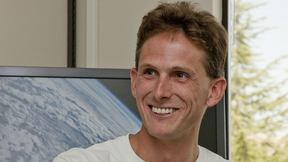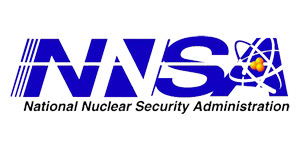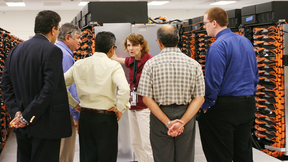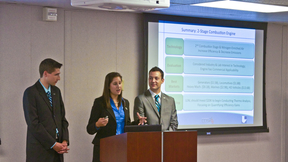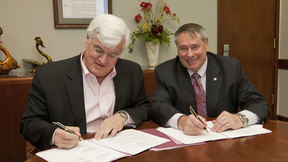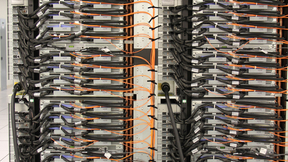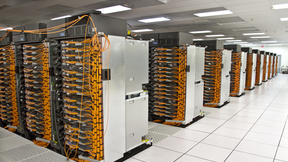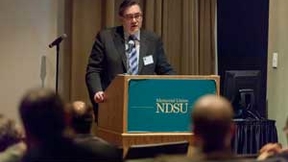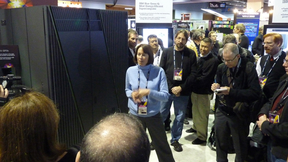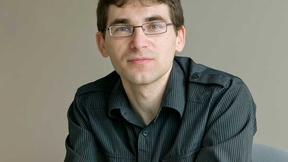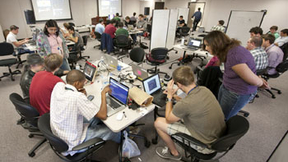Back
Sequoia, a world-class IBM BlueGene/Q computer sited at LLNL for the National Nuclear Security Administration (NNSA), is exploring a broad range of science to shakeout the machine and fully develop the capabilities the system will require to fulfill its national security missions, starting early next year. Researchers from NNSA's three nuclear weapons laboratories are…
Whether it is designing a cleaner more efficient combustion engine, analyzing energy use in buildings or improving oil and gas drilling methods, energy companies agree that Lab supercomputers and expertise are showing them ways to "think differently" and accelerate the development of new products and services. "When you have computing capabilities you didn't have before,…
Lawrence Livermore National Laboratory's Sequoia supercomputer has received a 2012 Breakthrough Award from Popular Mechanics magazine. Sequoia, an IBM BlueGene/Q machine, is ranked No. 1 on the industry-standard TOP500 list of the world's fastest high performance computing systems. Bruce Goodwin, principal associate director for Weapons and Complex Integration (WCI),…
The Laboratory's Sequoia supercomputer has been selected for a Breakthrough Award from Popular Mechanics magazine. Sequoia, an IBM BlueGene/Q machine, is ranked No. 1 on the industry-standard TOP500 list of the world's fastest high performance computing systems. Bruce Goodwin, principal associate director for Weapons and Complex Integration (WCI), Michel McCoy, head of…
Whether the challenge is academic or athletic, Laboratory computational scientist Jeff Banks has always set the bar high. In the end, hurtling down a runway to pole vault to a new height and grappling with a complex computational problem to take simulation to a new level tap the same inner drive. Banks, a pole vaulter in college, notes that technical people are often…
WASHINGTON, D.C. -- Under an initiative called FastForward, the Department of Energy (DOE), Office of Science and the National Nuclear Security Administration (NNSA) have awarded $62 million in research and development (R&D) contracts to five leading companies in high performance computing to accelerate the development of next-generation supercomputers vital to…
To lay the foundation for stronger collaborations to address national energy problems, the Laboratory recently invited researchers from leading universities to exchange ideas and mathematical approaches for leveraging high performance computing, and to identify areas for cooperative research. "This exchange of ideas is a great opportunity to build on existing…
Three University of Oklahoma (OU) students who took part in this year's Innovation for Green Advanced Transportation Excellence (i-GATE) Fellowship Program, presented the results of their five-week research project on the potential commercialization of a Lab clean combustion engine technology at a Tuesday symposium. The presentation was made in the Livermore Valley Open…
Lawrence Livermore National Laboratory (LLNL) and NASA's Ames Research Center (ARC) in Mountain View, Calif., have agreed to collaborate by sharing technology and resources on technical areas of national interest, including space missions, energy and advanced computing. LLNL director Parney Albright and ARC director Pete Worden signed the agreement Thursday in Livermore,…
Researchers at IBM and Lawrence Livermore National Laboratory (LLNL) today announced that they are broadening their nearly 20-year collaboration in high performance computing (HPC) by joining forces to work with industrial partners to help boost their competitiveness in the global economy. Under a recently concluded agreement, IBM and LLNL have formed an HPC collaboration…
Supercomputer at Lawrence Livermore National Lab passes 16 petaflopsWASHINGTON, D.C. - The National Nuclear Security Administration (NNSA) today announced that a supercomputer called Sequoia at Lawrence Livermore National Laboratory (LLNL) was ranked the world's most powerful computing system.Clocking in at 16.32 sustained petaflops (quadrillion floating point operations…
The Lab's Sequoia supercomputer is the world's fastest high performance computing system on the international ranking announced earlier today at the International Supercomputing Conference (ISC) in Hamburg, Germany. Clocking in at 16.32 sustained petaflops (quadrillion floating point operations per second), Sequoia earned the number one ranking on the industry standard…
LIVERMORE, Calif. -- Lawrence Livermore National Laboratory (LLNL) today announced the selection of six industry projects for the advancement of energy technologies using high performance computing (HPC). Called the "hpc4energy incubator," this pilot program aims to innovate and accelerate the development of energy technology and boost U.S. economic competitiveness in the…
Tomas Diaz de la Rubia, the Lab's deputy director for Science and Technology, discussed Monday how high performance computer modeling and simulation can accelerate the development of clean energy technologies in a keynote address at North Dakota State University (NDSU) in Fargo, N.D. The Laboratory was a co-sponsor of the "North Dakota Energy Symposium: Using Technology to…
The Blue Gene/Q Prototype II, now located at the IBM's T.J. Watson Research Center in New York and soon to be delivered to LLNL as the new Sequoia supercomputer for the Advanced Simulation and Computing (ASC) Program, won first place on the annual Graph 500 list.Blue Gene/Q was able to traverse more than 254 billion graph edges per second (TEPS), more than two and a half…
The BlueGene/Q supercomputing system that will be deployed at the Lab as Sequoia was officially unveiled by IBM in a brief ceremony at the start of SC11, the annual supercomputing conference. Kim Cupps, leader of the High Performance Computing (HPC) division, representing the Laboratory, paid tribute to the longstanding partnership with IBM and the computing breakthroughs…
Jerome P. Nilmeier, a biophysicist working in computational biology, is willing to bet his new research will provide a breakthrough in the use of the Monte Carlo probability code in biological simulations. Working with Gavin E. Crooks at Lawrence Berkeley National Lab, David D. L. Minh at Argonne, and John D. Chodera, from the University of California, Berkeley, Nilmeier…
The White House announced Monday that Lawrence Livermore National Laboratory (LLNL) computer scientist Greg Bronevetsky has been named a recipient of a Presidential Early Career Award for Scientists and Engineers for helping advance the state-of-the-art in high performance computing. The Presidential Early Career Awards for Scientists and Engineers, or PECASE, is the…
"Cyber Defenders" may sound like a new super hero movie. But, in reality, Cyber Defenders denotes a unique summer student program that trains a new breed of computer security professionals. Now in its second year at LLNL, the Cyber Defenders program led by Computation's Celeste Matarazzo, a principal investigator in the Center for Applied Scientific Computing, has enrolled…
It's not every day a Lab intern gets to meet a famous billionaire and philanthropist. But, Computation summer student TeAirra Brown recently did just that. Brown was one of five Gates Millennium Scholars selected to attend a reception with scholar program and Microsoft founder Bill Gates following his presentation about jobs of the future at the National Urban League…





